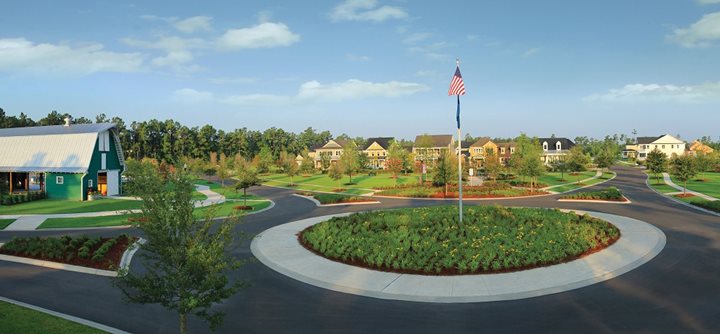
Carnes Crossroads in Summerville, SC
In 2013 the National Association of Realtors surveyed homebuyers to find out what was important to them when it came to community choice. Their Community Preference Survey indicates, “60 percent of respondents favor a community with a mix of houses, stores, and other businesses that are within walking distance, rather than a community requiring driving between home, work, and recreation. Respondents indicated that while the size of a home or yard does matter, most are willing to compromise size for a preferred community and less commuting.”
Americans are divided in their preferences. “There is a split between those who prefer a walkable community with a mix of housing, close by commerce, limited parking and public transportation as opposed to a more conventional single family houses only community, where driving is required and public transport is unavailable. Half prefer the walkable community and 45 percent prefer the conventional suburb model.”
These are only a few of the factors which people have expressed preference for when searching for a community. There are so many elements which must be considered when searching for your new home community. How do you know what you want? Let’s examine a few factors to consider.
Do you know what you want in your community?
When it comes to choosing your new home community you can choose from a conventional community in a suburban area or you can choose a master-planned community [How to know the Difference Between Community Types] that may include shops, schools, social activities, and recreational amenities.
The website Zurple suggests homebuyers examine communities based on five characteristics: Community, convenience, care, climate, and character. Consider ranking communities based on common elements which all great communities have: lifestyle match, pride in ownership, low crime rate, great schools, abundance of outdoor activities, a sense of history, access to medical care, family-friendliness, proximity to public transportation, nearby shopping and restaurants, nightlife and entertainment, and walkability. [What to Look for in a New Home Community].
Only you know what’s important to you
Here at Charleston New Home Guide, we’re great proponents of making lists. Before you start your house-hunt, conduct a community hunt. Start by developing a checklist of what you desire. Take inventory by specifying the lifestyle you want and the amenities and features you desire in your community. Remember to include factors such as proximity to your workplace and to schools. Also note the type of house you would like in that community, e.g. single-family, townhome, ranch home, cottage, bungalow, etc. It will help you if you can envision your ideal house and how it sits in relationship to that of your neighbors as well as to community amenities.
Once you know what you desire, then you can begin to factor out communities which don't meet your criteria. Use Charleston New Homes’ Guide new home Community List to learn more about communities in the Lowcountry. This all may sound tedious, however, if you don't begin from a logical point of understanding what you want, it's going to be very confusing if you find a home that you love in a community that doesn’t offer what you want. To make it easy, use the checklist from Neighborworks.org.
There are a number of tools available to you on the internet which can help you get information about the community you’re considering.
1. WalkScore.com: WalkScore is a single number which helps you comprehend how walkable a community is. Using the site, you can figure out how easy it might be to walk to shops, schools, and entertainment.
2. GreatSchools.org: GreatSchools is a website that aims to help parents learn about schools in their district. Ratings cover the overall school and can include parent submitted reviews and info about clubs, sports and location. The site even includes a tool to allow you to find homes for sale within the school’s attendance zone.
3. HomeFacts.com: HomeFacts is devoted to providing you a full picture of facts about a town, zipcode or area. Using the site, you’ll get a city report, schools overview, crime rate overview, registered offender data, real estate data, environmental hazards, and unemployment numbers. The site flags numbers which are better or worse than averages per category.
4. NeighborhoodScout.com: NeighborhoodScout gives you a community map, and lots of detail including, real estate price averages and overview, notable and unique community characteristics, community income, occupations, ethnicity and ancestry, information on commuting,
After refining your list, visit the community at various times of the day as well as various days through the week. Be aware of people walking, playing or enjoying the amenities as well as interacting with each other. Is the community peaceful? Quiet? Clean? Are the homes in the community well-kept and attractive? Are people out working in their yards? By taking note of all these things as well as your feeling of safety, you can begin to get a relatively good understanding of the community.
You should also speak with your Realtor® who can fill in more local details about each community on your list. A good Realtor will know lots of information that may not be so easily apparent.
Ultimately, you want to find a community where you are safe, feel welcome, and can develop a social network and feel that your home’s value will be sustained and enhanced by the community’s attractiveness.
###
Thank you for reading and sharing our articles from The Greater Charleston New Homes Guide. Our business is to know Charleston, SC's new home construction, home builders, neighborhoods, and homes so we may assist you as you take your new construction home journey. Please take the time to explore our site. The Greater Charleston New Homes Guide is considered the best and most reliable ‘local’ resource to new home construction, builders, neighborhoods and homes throughout the Lowcountry since 2004.
4.17
Tagged as: Home Buying Process
Categories: The Guide Tools